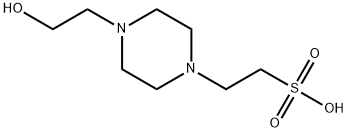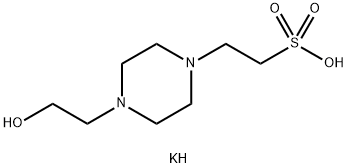HEPES
Synonym(s):HEPES;4-(2-Hydroxyethyl)piperazine-1-ethanesulfonic acid;HEPES solution;N-(2-Hydroxyethyl)piperazine-N′-(2-ethanesulfonic acid);N-2-Hydroxyethylpiperazine-N?-2-ethanesulfonic Acid
- CAS NO.:7365-45-9
- Empirical Formula: C8H18N2O4S
- Molecular Weight: 238.3
- MDL number: MFCD00006158
- EINECS: 230-907-9
- SAFETY DATA SHEET (SDS)
- Update Date: 2025-12-17 11:34:44

What is HEPES?
Description
HEPES has been described as one of the best all-purpose buffers available for biological research. At biological pH, the molecule is zwitterionic, and is effective as a buffer at pH 6.8 to 8.2 (pKa 7.55). It is typically used in cell culture at concentration between 5mM to 30 mM. HEPES has been used in a wide variety of applications, including tissue culture. It is commonly used to buffer cell culture media in air. HEPES finds its usage in in vitro experiments on Mg.
Chemical properties
White crystalline powder
The Uses of HEPES
Non-toxic to cell. It is used as a hydrogen ion buffer, which can control the constant pH range for long term. The concentration is 10-50mmol/L. Generally, 20mmol/LHEPES in nutrient solution can get buffer ability.
The Uses of HEPES
HEPES is a biological buffer. It may be used in isoelectric focusing applications and as a buffer in the quantitative and selective measurement of antigen-antibody reactions. HEPES is reportedly superior to NaHCO3 in controlling pH in tissue and organ culture. HEPES is not recommended for use with the Folin-Ciocalteu protein assay.
The Uses of HEPES
HEPES is common buffer for biological sciences, particularly used in cell culture to maintain physiological pH. It acts a buffering component, which is used in the preparation of buffers. It is described as one of the best all-purpose buffers available for use in biological research.
HEPES has been used as a component of:
Hank′s balanced salt solution, Dulbecco′s modified eagle′s medium and no-glucose DMEM, which are used for the preparation of tissue slices.
Buffers used in localized conductance measurements on the basolateral side of culture inserts to examine cation selectivity.
What are the applications of Application
HEPES Buffer Solution (1M) is a zwitterionic, all-purpose "Good′s" buffer for use in biological research
What are the applications of Application
HEPES is an N-substituted aminosulfonic acid buffer with an optimal buffering pH range of 6.0 to 8.5.
Definition
ChEBI: A HEPES that is ethanesulfonate substituted by a 4-(2-hydroxyethyl)piperazin-4-ium-1-yl group at position 2.
General Description
HEPES buffered saline is a tissue culture buffer, which is used to maintain the pH of cell culture. It is water soluble and atmosphere independent. HEPES destroys magnesium in sodium chloride solutions.
Biological Activity
Multi purpose buffer used in biological research.
Biological Activity
HEPES is a multi purpose HEPES buffer used in cell culture and other biological research. Working pH range in aqueous solution: 6.8 - 8.2. Does not form complexes with metal ions. Used in cell culture media.
Storage
Room temperature
Purification Methods
Crystallise the acid from hot EtOH and water. It is a useful buffer. [Beilstein 23 V 376.]
Properties of HEPES
| Melting point: | 234-238 °C |
| Boiling point: | 408℃[at 101 325 Pa] |
| Density | 1.07 g/mL at 20 °C |
| vapor pressure | 0Pa at 25℃ |
| refractive index | n |
| storage temp. | 2-8°C |
| solubility | H2O: 1 M at 20 °C, clear, colorless |
| form | powder |
| color | White |
| PH | 5.0-6.5 (1Maqueous solution) |
| pka | 7.5(at 25℃) |
| PH Range | 7.0 - 7.6 |
| Water Solubility | Soluble |
| λmax | λ: 260 nm Amax: 0.06 λ: 280 nm Amax: 0.04 |
| Merck | 14,4654 |
| BRN | 883043 |
| Stability: | Stable. Combustible. Incompatible with strong oxidizing agents. Protect from moisture. |
| CAS DataBase Reference | 7365-45-9(CAS DataBase Reference) |
| EPA Substance Registry System | 1-Piperazineethanesulfonic acid, 4-(2-hydroxyethyl)- (7365-45-9) |
Safety information for HEPES
| Signal word | Warning |
| Pictogram(s) |
 Exclamation Mark Irritant GHS07 |
| GHS Hazard Statements |
H302:Acute toxicity,oral H315:Skin corrosion/irritation H319:Serious eye damage/eye irritation H335:Specific target organ toxicity, single exposure;Respiratory tract irritation |
| Precautionary Statement Codes |
P261:Avoid breathing dust/fume/gas/mist/vapours/spray. P271:Use only outdoors or in a well-ventilated area. P280:Wear protective gloves/protective clothing/eye protection/face protection. |
Computed Descriptors for HEPES
| InChIKey | JKMHFZQWWAIEOD-UHFFFAOYSA-N |
HEPES manufacturer
New Products
4,4-Difluoropiperidine hydrochloride tert-butyl 9-methoxy-3-azaspiro[5.5]undecane-3-carboxylate Indole Methyl Resin N-Isopropylurea N,N-Dicyclohexylcarbodiimide(DCC) MELDRUMS ACID 5-METHYLISOXAZOLE-4-CARBOXYLIC ACID Magnessium Bis glycinate Zinc ascorbate 1-bromo-2-butyne 2-acetamidophenol 9(10H)-anthracenone Erythrosin B, 4-Piperidinopiperidine 2-((4-morpholinophenylamino) (methylthio) methylene) malononitrile 2,4-dihydroxybenzaldehyde 3-(4-morpholinophenylamino)-5-amino-1H-pyrazole-4-carbonitrile Methyl 2-methylquinoline-6-carboxylate 2,6-dichloro-4-nitropyridine 4-Bromo-2-chlorobenzonitrile 2-(benzylamino)acetic acid hydrochloride 4-(tert-Butoxycarbonylamino)but- 2-ynoic acid 3,4-dihydro-2H-benzo[b][1,4]dioxepine 1-Phenyl-1-cycloprppanecarboxylicacidRelated products of tetrahydrofuran





![OXO-[4-(2-SULFO-ETHYL)-PIPERAZIN-1-YL]-ACETIC ACID](https://img.chemicalbook.in/StructureFile/ChemBookStructure7/GIF/CB9397107.gif)
![2-(4-[(3-HYDROXYPHENOXY)ACETYL]PIPERAZIN-1-YL)ETHANESULFONIC ACID](https://img.chemicalbook.in/StructureFile/ChemBookStructure7/GIF/CB3680993.gif)

You may like
-
 HEPES-buffered saline CAS 7365-45-9View Details
HEPES-buffered saline CAS 7365-45-9View Details
7365-45-9 -
 HEPES buffer soln. CAS 7365-45-9View Details
HEPES buffer soln. CAS 7365-45-9View Details
7365-45-9 -
 HEPES Buffer extrapure CAS 7365-45-9View Details
HEPES Buffer extrapure CAS 7365-45-9View Details
7365-45-9 -
 HEPES Buffer for cell culture CAS 7365-45-9View Details
HEPES Buffer for cell culture CAS 7365-45-9View Details
7365-45-9 -
 Hepes buffer solution, 1M in water CASView Details
Hepes buffer solution, 1M in water CASView Details -
 HEPES BUFFER SOLUTION CASView Details
HEPES BUFFER SOLUTION CASView Details -
 HEPES buffered saline CASView Details
HEPES buffered saline CASView Details -
 Hepes, extra pure, 98%View Details
Hepes, extra pure, 98%View Details
7365-45-9
